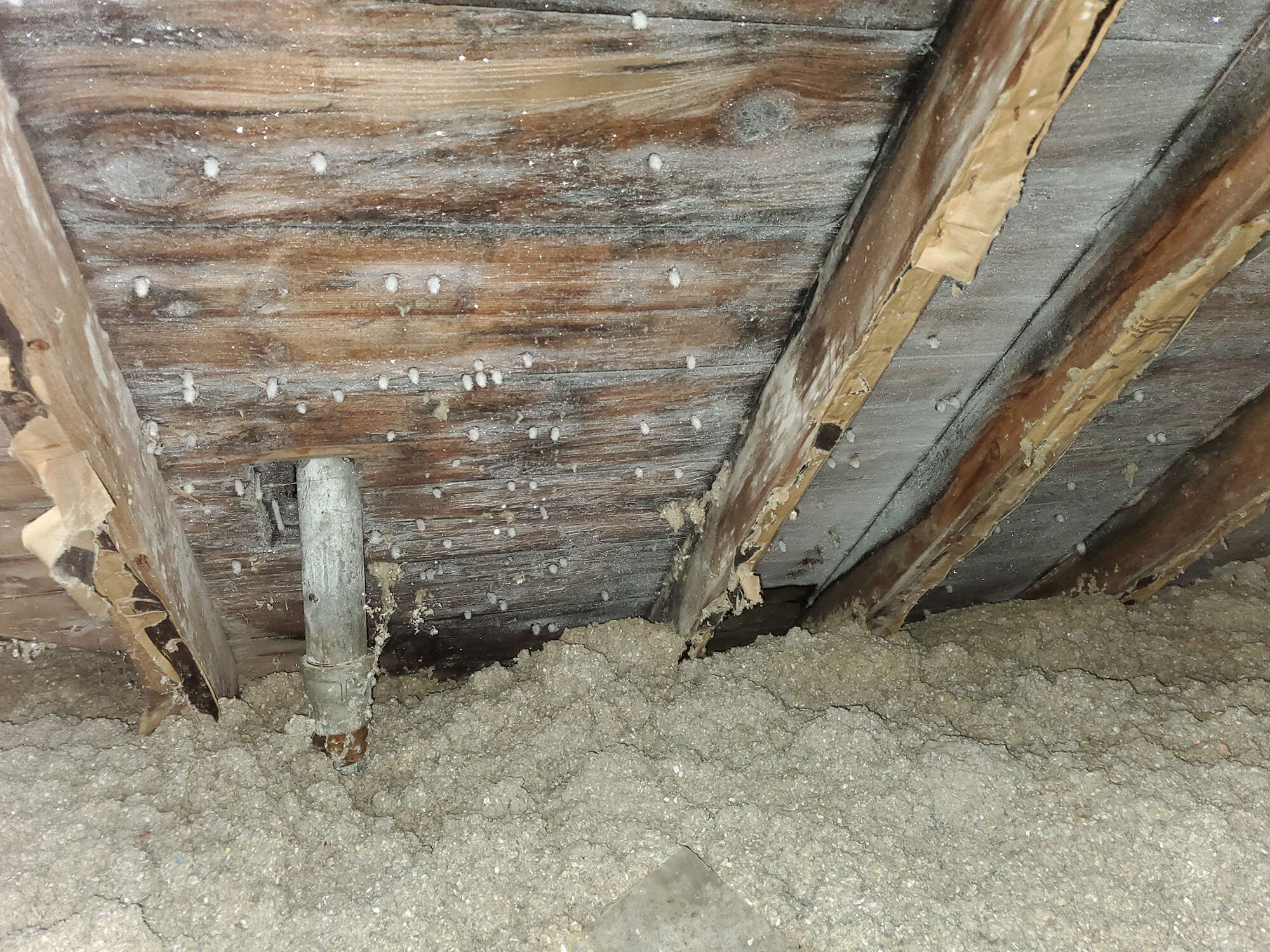Condensation or a Roof Leak?
Condensation in the attic - no vapor barrier below the insulation leads to water vapor freezing on the underside of roof boards.
Condensation in the attic can appear as a roof leak
Imagine reading a book or watching TV on the couch to set the stage. Your eye glances at the ceiling for only a moment, then snaps back on what appears to be several spots on the ceiling. “A roof leak!” Frantically you begin calling roofing companies. Mind you; this is happening in the middle of Winter. Desperation occurs, and you eagerly await XYZ Roofing to show up. A new roof is prescribed. A picture of a ceiling cave-in rushes through your mind. The problem is several roof leaks. The solution is a new roof. Roof leaks mean replacing or repairing the roof? Right? Wrong! In this case, getting on a new roof list will solve nothing. In this case, we are focusing on condensation. Condensation is not a roof leak. It can easily appear as a leak. Determining if it is, in fact, is condensation or an actual roof leak takes a professional. There are two different solutions for completely different problems.
Don’t fall into the brand new roof trap because of condensation. Determine what is happening.
Roof leaks typically occur in roof transitions or roof penetrations and not generally out in the roof's open parts.
Condensation tends to occur in large areas and is not focused like a roof leak. Frost or moisture found on the roof deck's underside is the #1 symptom.
Replacing shingles on the roof when condensation is the culprit is not solving the problem. New shingles and synthetic felt can make the problem worse because the roof is becoming tighter and less prone to breathing.
Condensation is originating from the home. Cooking, bathing, washing, and just occupying the home translates to condensation.
Poor insulation and missing vapor barriers allow water vapor easy access to the attic; inadequate ventilation is allowing it to stay.
What is Condensation in a House?
Condensation occurs when warm, humid air accumulates on much colder items. This changes the state of water to a solid when it’s below freezing, then to a liquid when above freezing. Condensation occurs commonly in the home during Minnesota Winters. It can easily be seen on windows when it’s cold outside and warm inside. The greater the temperature difference, the more condensation. The photo below shows the glass or pane of the window has little resistance to heat (not a good insulator) and is much colder than the insulated wall next to it. Water droplets form from the moisture-laden air and accumulate inside the glass pane. Windows are commonplace for condensation to manifest because of this temperature swing. Seeing condensation on windows is easy enough. Finding condensation in an attic space requires a little investigation. The image above shows frost build-up on the roof boards' underside and frost accumulating on the nails that have penetrated. This translates to “It’s cold outside,” and expected Frost happens when it’s cold. It’s actually condensation in the attic. This particular structure is a story-and-a-half farmhouse with little knee wall spaces on the sides of living spaces. These little knee walls/attic spaces are supposed to be unconditioned but can become partially conditioned because of heat loss. This means the space becomes warmer than the outside air. Non-livable attic spaces should resemble the outside temperature or as close as possible. The condensation occurs from the lack of a vapor barrier. The vapor barrier is a plastic film behind the drywall that stops moisture transmission. Condensation can easily appear as a leak in the situation above when the weather warms up, and the frost melts.
Condensation appearing on a window during cold Winter months
Condensation damage will happen when the weather is right
Condensation can be very inconsistent. One Winter month it can be terrible and the next month manageable. Cold snaps and warm ups are causing the water vapor accumulated in the attic to freeze or thaw. The more frequent these freeze thaw cycles the more water the insulation has to absorb. A missing vapor barrier means any moisture that makes contact with the drywall can soak through and be a problem. The middle photo below shows what borderline manageable condensation looks like in cellulose blown insulation. This water dries before it can absorb too far down, but the little trails are signs of water dripping in the past. The left photo is showing how damaging condensation can appear. The moisture build-up was so great that the plywood warped and popped nails in the early Spring. To add to the mess it was creating mold and mildew problem in the process. The right photo is showing how we terminate vents the proper way. When fan and vents are done properly the moisture from bathrooms and range hoods can escape versus accumulating in the attic space.
Solving Condensation in the Roof is a continuation of this article
Underside of plywood in attic space that is black because of moisture, mildew, and mold
Water droplets from condensation build up in cellulose insulation
Here is a bathroom vent termination through the roof that is done properly and will eliminate condensation
Condensation is very common in Minnesota, addressing little things can slow it down or solve it.
Pair yourself with a contractor that can help solve these issues, Reach out to Rooftop Solutions this Spring, Summer, or Fall for a look at your roof and attic space.
Additional Articles on Condensation





